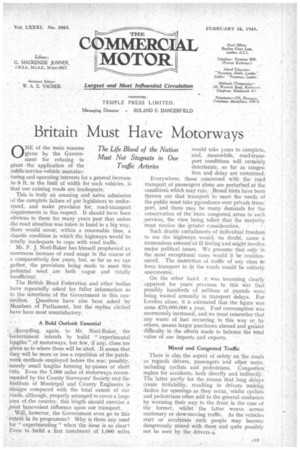Britain Must Have Motorways
Page 21

If you've noticed an error in this article please click here to report it so we can fix it.
NE of the main reasons given by the Govern ' ment for refusing to grant the application of the oublic-service-vehicle manufacturing' and operating interests for a general increase to 8 ft in the limit of width for such vehicles, is that our existing roads are inadequate.
This is truly an amazing and naive 'admission of the complete failure of our legislators to understand, and make provision for, road-transport requirements in this respect. It should have been obvious to them for many years past that unless the road situation was taken in hand in a big way, there would occur, within a reasonable time, a chaotic condition in which the highways would be totally inadequate to cope with• road traffic.
' Mr. P. J. Noel-Baker has himself prophesied an enormous increase of road usage in the course of a comparatively, few years, but, so far as we can gather, the provisions being made to meet this potential need are both vague and totally insufficient.
The British Rbad Federation and other bodies have repeatedly asked for fuller information as to the intentions of the Government in this connection. Questions have also been asked by • Members of Parliament, but the replies elicited have been most unsatisfactory.
A Bold Outlook Essential • According again, to Mr. Noel-Baker, the GovernMent intends to build "experimental lengths ".,of motorways, but few, if any, clues are given as to where these will be sited. It seems that they will be more or less a repetition of the patchwork methods employed before the war, possibly, merely small lengths forming by-passes or short huts. Even the 1,000 miles of motorways recommended by the County Surveyors' Society arid the Institute of Municipal and County Engineers is Meagre compared with the total extent of our roads, although, properly arranged to cover a large area of the country, this length should exercise a inest benevolent influence upon our transport.
Will,.however, the Government even go to this extent in its programme? Why is there any need for " experimenting " when the issue is so clear? Even to build a first instalment of 1,000 miles would take years to complete, and, meanwhile, road-transport conditions will certainly deteriorate, so far as congestion and delay are concerned: Everywhere, those concerned with the road transport of passengers alone are perturbed at the condition's which may rule. ,Broad hints have been thrown out that transpoft to• meet the needs of the public must take prscedence over private transport, and there may be many demands for the conservation of the more congested areas to such services, the view being taken that the• majority must receive the greater consideration.
Such drastic curtailments of individual freedom to use the highways would, no doubt, cause a tremendous amount:of ill feeling and might involve major political issues. We presume that only in the most exceptional cases would it be countenanced. The restriction of traffic of any class to force transport to fit the roads would he entirely uneconomic.
On the other hand. it was becoming clearly apparent for, years previous to this vilar that possibly hundreds of millions of pqunds were being wasted annually in transport delays. For London alone, it is estimated that the figure was some £70,000,000 a year. Fuel consumption was enormously increased, and we must remember that any waste of fuel occurring in this way or by' others, means larger purchases abroad and greater difficulty in the efforts made to balance the total value of our imports and exports.
Mixed and Congested Traffic There is also the aspect of safety on the roads as regards drivers, passengers 'and other users, including cyclists and pedestrians. Congestion mikes for accidents, both directly and indirectly. The latter partly for the reason that long delays create irritability, resulting in drivers making dashes for openings as they occur, 'whilst cyclists and pedestrians often add to the general confusion by worming their way to the front in the case of the former, whilst the latter weave across stationary or slow-moving traffic. As the vehicles start or accelerate such people may become dangerously mixed with them andquite possibly not be seen by the drivers.




























































